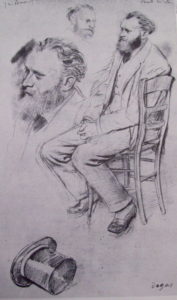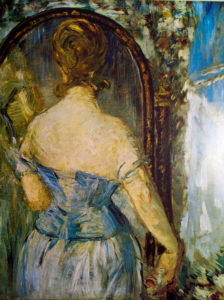“There is only one true thing: Instantly paint what you see. When you’ve got it, you’ve got it. When you haven’t, you begin again. All the rest is humbug.” – Edouard Manet

“We didn’t know that he was this great,” commented Edouard Manet’s friend, Edgar Degas, shortly after Manet’s death. This was understandable since Manet the man had carefully hidden Manet the artist. The passing of Manet the man suddenly exposed Manet the artist with utmost transparency.
Manet’s friend, the esoteric poet at the time, Stephen Mallarme, described him as “the only man who tried to open up a new path for himself and for all painting.”

Few artists are kind to their colleagues, and although Paul Cezanne never cared for Manet’s personality, he declared that with Edouard Manet began “a new state of painting.”
Gauguin often was quoted as flatly stating: “Painting begins with Manet.”
No one at the time doubted that Manet deserved the epithet revolutionary. Often modified, but never basically questioned was the state of painting since the 14th century. this is what Manet overthrew, creating a new state of painting – modern painting.
Manet’s painting, Before the Mirror, defines what his revolution was about. The painting depicts a woman (probably of easy virtue), partially dressed with her back toward the viewer. She seems to be gazing at herself in the mirror.
Mirrors were not new for artists. They were often used by all artists as symbols of their profession, reflecting not only the model portrayed, but also the art of painting.
However, Manet changed the concept of art, thus the revolution. For centuries, the clarity of the images in mirrors painted by artists was the success or failure of the artist. In his painting, Before the Mirror, Manet never even tried to paint the image in the mirror. He did something strange. Instead of seeing the young woman’s likeness in the mirror, their is a plethora of loose brush strokes, rough, and thick. All we see is paint!
The confused art world went crazy, but in 1890, more than a decade after Manet painted Before the Mirror, artist Maurice Denis explained Manet’s relationship between the subject depicted and the act of depicting in this manner: “Remember that a picture – before being a war horse, a nude woman, or an anecdote – is essentially a plane surface covered with colors assembled in a certain order.” Manet brought about an art revolution in the 19th century that has lasted to this day. Be free artist. Their are no rules.
It was not Before the Mirror that was Manet’s only clash with the art world. Many of his paintings confused, and changed the way art was conceived. However, as all great people do, they just do.
Be sure to join our newsletter (top right).
Enjoy our art galleries above.
Go to my FB page (right) and “like” if you do.
Thanks.
